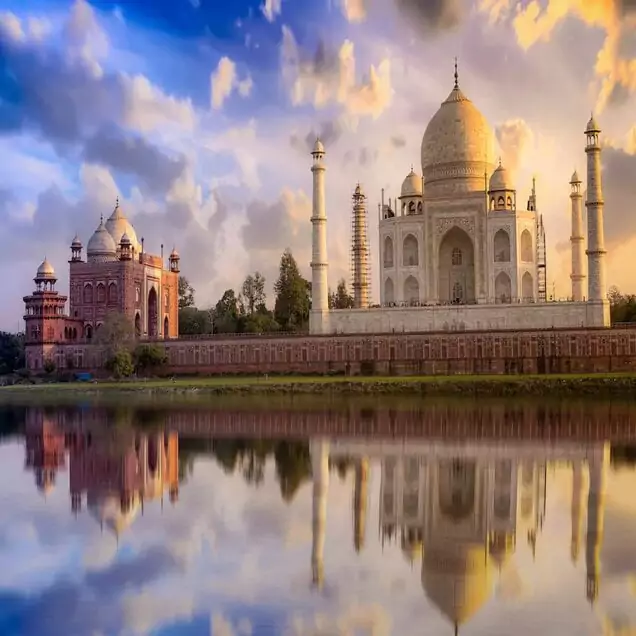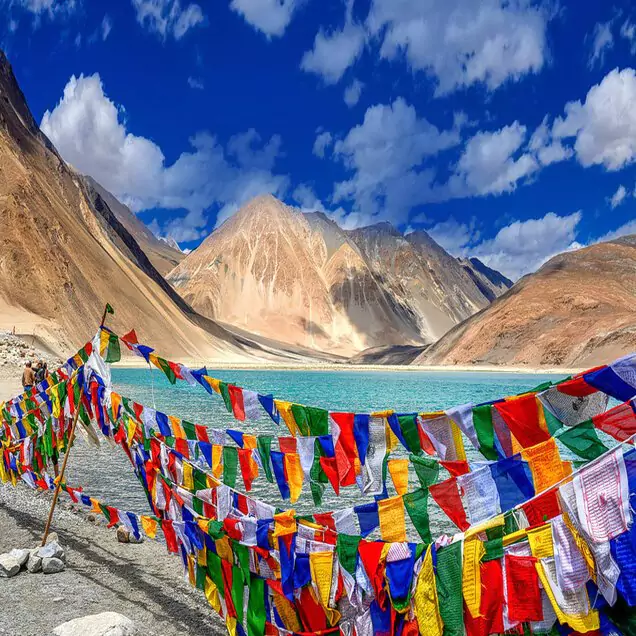

Introducing India
India is an extremely diverse country, with vast differences in geography, climate, culture, language and ethnicity across its expanse, and prides itself on being the largest democracy on Earth and a hub of trade in Southeast Asia. India provides a vast canvass for touring whether it may be cultural, adventure, religious, history, beach or wildlife.
India offers a myriad of flavours mingling in the steam of a country coming of age. Teeming with over a billion people who voice over a million concerns in fifteen hundred different languages, India is where people live with variety, thrive on diversity and are too familiar with largeness to let it boggle them.
Travellers and tourists to India may, however, find it daunting. Mud huts and mansions face off across city streets and luxury and limp are inhabitants of the same lane. Just like in the masala box in every Indian kitchen, measures of Calm and Kaam (work) craft the people of India. In this beautiful and bountiful land that is India, events, experiences and sensations heap themselves on the tourist at every step. India will be one of the most stimulating places you’ll ever visit.
- Discover the Wonders of India
India, a land of diversity and contrasts, is a mesmerizing tapestry of history, culture, and natural beauty. From the majestic Himalayas to the tropical beaches of the south, India offers a kaleidoscope of experiences for every type of travellers.
- Historical Marvels: India’s history is etched in its architecture. The Taj Mahal in Agra, a UNESCO World Heritage Site, stands as an enduring symbol of love. The ancient city of Varanasi, on the banks of the Ganges, reflects the spiritual and cultural heart of India.
- Cultural Diversity: India is a mosaic of cultures, languages, and traditions. Each state is a treasure trove of unique customs, festivals, and cuisine. From the colorful dances of Rajasthan to the classical arts of Kerala, every region contributes to India’s rich cultural tapestry.
- Spirituality and Philosophy: Varied spiritual practices coexist in India, from Hinduism and Buddhism to Jainism and Sikhism. The sacred city of Rishikesh, nestled in the Himalayas, is a hub for yoga and meditation. The ghats of Varanasi and the temples of Khajuraho reflect the spiritual diversity of the country.
- Natural Wonders: India’s geography is as diverse as its culture. The backwaters of Kerala, the tea plantations of Darjeeling, and the deserts of Rajasthan showcase the country’s natural beauty. National parks like Ranthambhore and Jim Corbett are havens for wildlife enthusiasts.
- Culinary Delights: Indian cuisine is a festival of flavors. From the fiery curries of the north to the coconut-infused dishes of the south, the gastronomic journey is a delight for the senses. Street food markets in cities like Delhi and Mumbai offer a tantalizing array of treats.
- Modern Metropolises: India’s cities blend ancient traditions with modernity. Delhi, Mumbai, and Bangalore are bustling metropolises with thriving economies, diverse populations, and vibrant arts scenes. The tech hub of Hyderabad and the Pink City of Jaipur add further layers to India’s urban landscape.
- Festivals and Celebrations: India is a land of festivals, celebrating the diversity of its traditions. Diwali, the Festival of Lights, and Holi, the Festival of Colors, are celebrated with unmatched enthusiasm and joy. The Kumbh Mela, held every 12 years, is one of the largest religious gatherings in the world.
- Traditional Arts: India’s artistic heritage is rich and varied. Classical dance forms like Bharatanatyam and Kathak, classical music, and intricate traditional crafts like pottery and weaving are integral to the country’s cultural identity.
India, with its vibrant tapestry of traditions, landscapes, and experiences, invites travellers on a journey of discovery. Whether exploring ancient monuments, relishing diverse cuisines, or immersing oneself in spiritual practices, every moment in India is a celebration of life’s myriad hues.
- When is the best time to visit?
The best time to visit India depends on the region and the experiences you seek. India experiences diverse climates due to its vast geography. Here’s a general guideline:
- North India (October to March): The winter months are the most pleasant for visiting North India. Cities like Delhi, Jaipur, and Agra experience mild temperatures, making it ideal for exploring historical sites and enjoying cultural experiences. This period is also suitable for exploring the Himalayan regions.
- South India (November to March): South India has a tropical climate, and the winter months are considered the best time to visit. Kerala, Karnataka, and Tamil Nadu offer comfortable temperatures for exploring beaches, hill stations, and cultural attractions.
- East India (October to March): The autumn and winter months are the most favorable for visiting states like West Bengal, Odisha, and Bihar. This is the time to explore cultural festivals, historical sites, and the natural beauty of the region.
- West India (October to March): The winter months are also the best time to visit states like Maharashtra, Gujarat, and Rajasthan in the west. Whether it’s the vibrant festivals in Mumbai, the deserts of Rajasthan, or the beaches of Goa, the weather is generally pleasant during this period.
- Himalayan Region (March to June and September to November): These months are suitable for visiting the Himalayan regions, including Himachal Pradesh and Uttarakhand. Spring and autumn offer clear skies, comfortable temperatures, and are ideal for trekking and exploring mountain landscapes.
- Monsoon Season (June to September): The monsoon season brings heavy rains to many parts of India. While it’s a spectacular time to witness the lush landscapes, it can also result in floods and travel disruptions. However, regions like Kerala and some parts of the Himalayas have unique attractions during the monsoon.
Ultimately, the best time to visit India depends on your preferences and the specific regions you plan to explore. Whether you’re seeking cultural experiences, natural beauty, or festive celebrations, India offers something special throughout the year.
- Where Should You Go?
India is a large and diverse country with many different regions, each with its own unique culture, history, and attractions. Here are some iconic destinations you might consider:
- Delhi: Explore India’s capital, where history meets modernity. Visit historic sites like the Red Fort and Humayun’s Tomb, experience the bustling markets of Old Delhi, and marvel at the grand architecture of India Gate.
- Agra: Witness the breathtaking Taj Mahal, a UNESCO World Heritage Site and one of the Seven Wonders of the World. Explore the Agra Fort and immerse yourself in the city’s Mughal history.
- Jaipur: Known as the Pink City, Jaipur is famous for its vibrant culture and historic architecture. Visit the Hawa Mahal, City Palace, and the Amer Fort for a glimpse into Rajasthan’s royal heritage.
- Varanasi: Experience the spiritual and cultural heart of India in Varanasi, along the banks of the Ganges. Witness mesmerizing Ganga Aarti ceremonies, explore narrow alleys, and visit ancient temples.
- Mumbai: India’s financial capital, Mumbai, is a melting pot of cultures. Explore historic landmarks like the Gateway of India, enjoy the vibrant street food, and experience the lively atmosphere of the city.
- Kerala: Discover the serene backwaters of Kerala, where houseboats glide through picturesque landscapes. Relax on the beautiful beaches, explore spice plantations, and witness traditional Kathakali dance performances.
- Goa: Known for its beautiful beaches and vibrant nightlife, Goa offers a perfect blend of relaxation and entertainment. Explore colonial architecture, enjoy water sports, and savor the unique Goan cuisine.
- Rishikesh and Haridwar: These spiritual destinations on the banks of the Ganges are known for yoga and meditation. Experience the Ganga Aarti, embark on trekking adventures, and find tranquility in the foothills of the Himalayas.
- Rajasthan’s Udaipur: Udaipur, the City of Lakes, is known for its romantic ambiance. Explore the City Palace, enjoy a boat ride on Lake Pichola, and wander through the vibrant markets.
- Himalayan Regions: For breathtaking landscapes and adventure, explore the Himalayan regions of Himachal Pradesh and Uttarakhand. Visit Shimla, Manali, or Rishikesh for a mix of natural beauty and adventure activities.
These are just a few of the many incredible destinations and attractions that India has to offer. Each region has its unique culture and history, and offers different experiences, therefore it’s important to do your research and plan your vacation accordingly.
- How Many Days Do You Need?
The ideal duration for a trip to India depends on the specific regions you want to explore and your travel preferences. Here’s a general guideline:
- Golden Triangle (Delhi, Agra, Jaipur): For a classic introduction to India’s history and culture, a 7-10 day trip covering the Golden Triangle is recommended. This allows you to explore the key landmarks and immerse yourself in the vibrant cities.
- North India (Delhi, Varanasi, Rishikesh, Haridwar): If you wish to delve into spiritual and cultural experiences, a 10-14 day trip covering North India is suitable. This allows time for exploring historic sites, attending spiritual ceremonies, and enjoying the serene landscapes.
- South India (Kerala, Goa): For a more relaxed trip with a focus on nature and cultural diversity, plan for 10-14 days in South India. Explore the backwaters of Kerala, relax on the beaches of Goa, and immerse yourself in the unique traditions.
- Mumbai and Western India: If you want to experience the vibrant culture of Mumbai and explore the western regions, a 7-10 day trip is recommended. This includes exploring Mumbai’s landmarks and enjoying the coastal beauty of places like Goa.
- Himalayan Regions and North: For adventure enthusiasts and nature lovers heading to the Himalayan regions, plan for a 14-21 day trip. This allows time for trekking, exploring hill stations, and experiencing the unique Himalayan culture.
- Comprehensive Tour: If you aim for a more comprehensive tour covering multiple regions, a 21-30 day trip or more would be ideal. This duration allows you to explore diverse landscapes, experience different cultures, and engage in various activities.
Keep in mind that these are general recommendations, and the actual duration may vary based on your interests, travel pace, and the specific places you want to visit. India offers a rich and diverse tapestry of experiences, and the duration of your trip can be tailored to match your preferences.
Your journey through the wonders of India begins here – with Travoley.
- ✔ TRAVEL TO INDIA WITH US
Embark on an extraordinary journey through the kaleidoscope of India with us. Our expertly crafted itineraries promise an immersive and enriching experience, unveiling the wonders of this diverse and culturally rich land. Whether you seek the bustling energy of Delhi, the iconic beauty of the Taj Mahal, the spiritual serenity of Varanasi, or the tranquil backwaters of Kerala, our journeys are designed to create lasting memories. Join us in exploring India’s ancient history, vibrant traditions, and breathtaking landscapes, where every moment is a revelation and every destination tells a story. Your dream Indian adventure begins here, with Travoley.
Sights
Map
Info
With its sumptuous mix of traditions, spiritual beliefs, festivals, architecture and landscapes, India will set your memories ablaze long after you’ve left its shores.




























